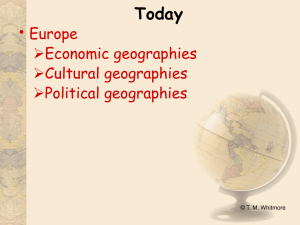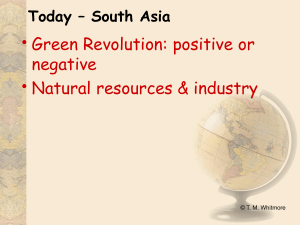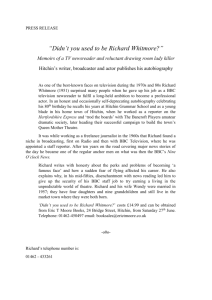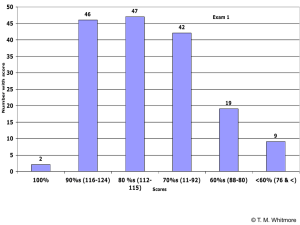7-23-industrializati..
advertisement
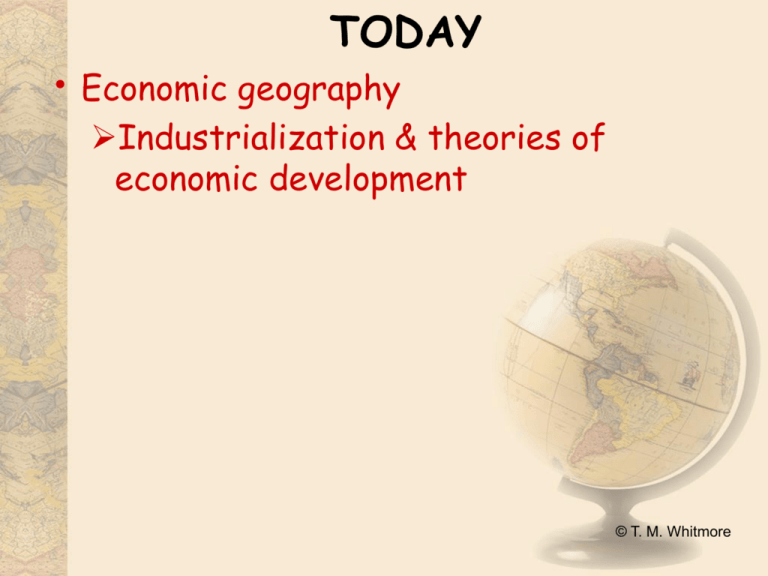
TODAY • Economic geography Industrialization & theories of economic development © T. M. Whitmore LAST TIME • Social Geography Wealth Race Religion © T. M. Whitmore Industrialization in the late 19th Century — up through WWII • Export Processing Industrialization (a • • follow on from colonial patterns) Low technology manufacture of basic consumer goods Era of WW I; Great Depression; through WW II © T. M. Whitmore Import Substitution Industrialization (ISI) (1940s — 1970s) • Legitimized by Argentine economist Raul Prebish in 1940 and adopted as official policy by the UN after WWII © T. M. Whitmore How ISI works • Imposed quotas or tariffs to increase • • the price of imported manufactured goods Idea is to stimulate local industries NOT a new idea © T. M. Whitmore Consequences of previous rounds of industrialization • A legacy of: Colonial; 19th C; and • • especially ISI industrialization Spatially uneven: largest states benefit most Smaller states forced to band together © T. M. Whitmore • • • • Assumptions of ISI Presumes that “under development” is partly the result of uneven terms of trade between LA and the more developed Atlantic world Isolating the country’s economy from the wider world’s economy will allow it to develop without the pressures from the Atlantic World Attempt to recreate a mini-model of the economy of more developed states Strongly involve the state in economic activities via state enterprises etc. © T. M. Whitmore Problems with ISI • Modern technology & jobs • Changed imports did not stop them • Foreign control continued • Governmental role increased • Subsidies & control Inefficient and corrupt industries © T. M. Whitmore Impacts of ISI development • ISI and general growth in 1960s led to • • • • increased borrowing by LA nations By 1980s loans became due but growth anticipated from ISI was not sufficient Neo-liberal reforms or “Conditionality” as a plan to work out debt Higher interest rates, higher cost oil, etc => great levels of inflation beginning in 1970s Inflation => elites took their money out of LA to US and Europe © T. M. Whitmore Growth Pole Industrialization (1950s-60s) • Concentrate on key parts of economy • Develop specific locations E.g., Arica Chile Amazonia and NE Brazil Ciudad Guyana © T. M. Whitmore Export Promotion Industrialization • • • Due to failures of ISI and need of LA countries to satisfy banks from whom they borrowed to do the ISI Idea was to mimic success of Asian “Tigers” Based on “neo-classical” economic ideas Assumes that markets manage best Thus, open markets best (lower or eliminate tariffs) (tariffs are usually reciprocal) Allow transnational corporations Thus, attempts to create zones of free trade © T. M. Whitmore Export Promotion Industrialization II • Main advantage of LA in world economy (in addition to availability of some raw materials and agricultural products) for manufacturing is Location near USA mkt. The low cost of labor => laborintensive (assembly) industries © T. M. Whitmore Export Promotion Industrialization III • Mexico and Brazil initially first in this • • due to their already existing industrial infrastructure E.g., auto factories initially designed for ISI changed to export This pattern is greatest in the sphere of small-scale assembly of finished goods or parts – often in special zones These are usually referred to as © T. M. Whitmore Maquiladora assembly plants Current industrialization • Mexico + Brazil ~ ½ of Latin American • • • population but > 70% of industrial output Brazil ~ 1/3 of pop but has ~ ½ industrial output by itself Argentina, Peru, Venezuela have ~ 25% of industrial output in LA Thus, ALL the rest of LA combined has less than 10% of all industrial output © T. M. Whitmore SUDAN Ciudad Guyana © T. M. Whitmore Auto train near Saltillo. Mexico © T. M. Whitmore © T. M. Whitmore Kenworth (18 wheelers) exported FROM Monterey, Mexico to USA © W.H. Freeman & Co. © T. M. Whitmore © T. M. Whitmore © T. M. Whitmore © Secretaría de Economía, Mexico © T. M. Whitmore © W.H. Freeman & Co. © Zachary Miles Baddorf. www.baddorf.com © Amnesty International © T. M. Whitmore © T. M. Whitmore © T. M. Whitmore © T. M. Whitmore


